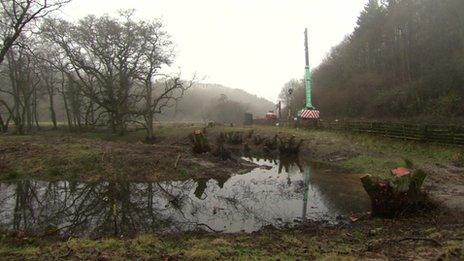Back-to-nature flood schemes need 'government leadership'
- Published
Natural flood defences, like felling trees into rivers to slow their flow, have proved successful
Water experts are calling on ministers to show greater leadership on flooding.
They say the government is failing to promote back-to-nature schemes which protect lowland homes by deliberately creating floods in the hills.
The Chartered Institution of Water and Environmental Management (CIWEM) say upland schemes to slow river flow cost a fraction of conventional flood walls – and should be spread round the UK.
Ministers back the principle but say the details need to be worked out.
The idea of creating floods upstream to prevent floods downstream was a key message from the Pitt Review into the 2007 floods.
A handful of pilot projects have pioneered cheap small-scale measures like felling trees into streams to slow down the flow, and building earth banks to catch run-off water and allow it to soak away.
One low-tech scheme in the hills above Belford in Northumberland cost about £300,000. It was put in place after a study suggested the cost of conventional flood defences would cost £4m.
But progress nationally has been slow, with funding a major problem.
'Complicated'
Katherine Pygott, from CIWEM, told the BBC: “Flooding is getting worse with changing weather patterns, but these schemes are taking a very long time and a lot of energy.
“Projects working with nature to reduce flood risk are needed right across the country but it is complicated with many different organisations involved and it will need political leadership from the highest level to make it happen. So far we haven’t seen that leadership.”
The upland schemes are designed to reduce the regularity of flooding, not remove risk completely. Conventional flood defences will still be needed but CIWEM estimates that re-wilding rivers will save ten of millions by reducing the peak flow and lowering the specification for flood walls. The projects should also benefit wildlife.

Work has begun in the hills above Pickering, North Yorkshire, to slow the flow of the river and keep water in upstream catchments away from villages
Phil Welton, from the Environment Agency, says the UK should aspire to have "a pond in every field in the areas where flood prevention is needed.
"We have got to give incentives to farmers to persuade them to capture water on their land," he argues. "Farmers will lose a bit of land – but these areas are only wet for two to three days a year and quite often they are on bits of land that farmers don't use – boggy areas or buffer strips.”
'Leap of faith'
Incentives for farmers are one key sticking point. In theory, funds from the Common Agricultural Policy can be used for catchment management but in practice Ms Pygott says that the standard of proof is much higher than for biodiversity projects which can also be supported under the CAP.
“With biodiversity schemes a farmer simply has to show that he has changed the land in a way that’s expected to benefit wildlife," she adds. "With flood schemes they have to prove what the benefits will be and that’s very hard.
"We obviously don’t want to be wasting government money on the wrong projects but with weather patterns changing it really makes sense to take a leap of faith on this and say it’s obvious these schemes are going to help if you get them in the right place.”
While farmers’ union NFU supports the idea in principle, it maintains it is not a "panacea" and will not alleviate flood risk in all parts of the country.
"It is most beneficial in steeper catchments where rainfall is quickly funnelled into rivers that can result in high peaks in flows," its flood adviser Ian Moodie warned. “The measures are less likely to be beneficial within lowland areas such as the Somerset Levels where we’ve seen a lot of flooding in recent years.”
Ownership issues
Taking the pilot schemes into upland areas nationwide will not be easy. CIWEM say thousands of farms need to be visited and surveyed to see where micro-schemes can be placed to protect catchments – a tough demand when Defra and the Environment Agency are shedding staff.
Environment Secretary Owen Paterson told the BBC he was "passionate about keeping water in the uplands but details of how to do this need to be resolved".
CIWEM say the quickest results for back-to-nature drainage will come in areas where land is owned by a few people.
For instance, near Pickering in Yorkshire, flood zones are being created and moorland drains stuffed with heather with the co-operation of just three large landowners including the Forestry Commission.
It was the need for forestry and farm output which saw the UK’s uplands drained in the first place when the farm department MAFF urged landowners to maximize productivity to overcome the U-boats during the Second World War.
Nearly seven decades later there’s still no concerted nationwide attempt to keep the rain on the uplands where it falls.
Follow Roger on Twitter @rharrabin
- Published10 January 2014
- Published10 January 2014